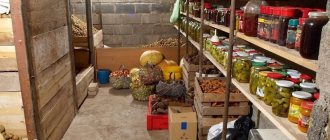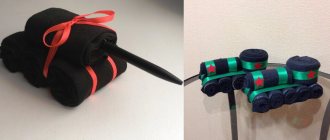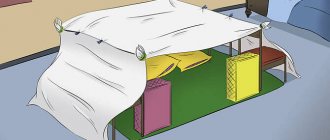How to make a pattern for sewing fleece socks
You can create a pattern yourself according to the principle described in the article on how to sew fleece boots with your own hands.
Below are ready-made anatomical patterns that can also be used and adjusted to your size.
Step-by-step master class with photos
The sock pattern is made taking into account 5 mm allowances, it is suitable for foot size 36. That is, there is no need to add allowances. In any case, before you start cutting fabric, you should compare your own dimensions and finished patterns, making changes if necessary. For example, by increasing the width of the sole or boot.
- Transfer the outline of the pattern onto the fabric, cut out the details. Compliance with the shared thread is a prerequisite. Otherwise, the product will stretch in length instead of expanding in width.
- Connect the heel areas and stitch them.
Anatomically shaped product for left and right legs. Therefore, it is advisable to immediately separate the parts so as not to confuse them during sewing. - After connecting the heels, spread the seams on different sides and sew with any flat seam or zigzag. This manipulation is not necessary, but it strengthens the seam and makes it invisible. Then trim off any excess seam allowance fabric.
- Place the top of the sock over the sole, connecting the crown and the side protruding corners. The top part will be shorter than the bottom - this is how it should be.
- Gather the long section a little, equalizing the dimensions, pin or sweep. Stitch. This margin is made in order to give freedom of movement, and at the same time, to avoid folds on the back of the foot.
- Sew along the sides.
- Sew the fabric for the cuff into a ring, then fold it in half.
- Place the cuff inside the sock and align the cuts. It is advisable to lay a stitch in a circle using an overlocker, or an elastic machine stitch, or stitch with a zigzag.
- Turn the product inside out and straighten it.
The folds make these socks look very funny. But they straighten out on the leg, and the model itself sits very comfortably on the leg.
Step-by-step construction of a pattern for fleece socks with your own hands
Pattern for sizes 34-36.
By increasing or decreasing the size of the squares - cells, we can adjust the size of the socks.
There are quite a lot of patterns for sewing socks, from simple ones of two or three parts to complex ones, for example, the Japanese style.
Important! Remember that we need all the details in duplicate, a mirror image. Our socks need a pair.
How to sew baby socks with your own hands
You can sew socks for your child like booties. Options for finished patterns are presented below.
Connect the cut elements by matching the control points marked with the same letters. Sew along the outline, then sew on the cuff. For babies, it is advisable to place the seams on the outside.
Simple socks - booties for a child
How to adjust the pattern to size: measure the length of the baby’s foot, then reduce or increase the sole of the finished pattern. Measure the circumference of the lower leg and compare it with the pattern, make changes if necessary.
This master class shows two-layer booties, so for each leg the parts are cut out in two copies: the lining and the outer part.
- Cut out the top and sole in duplicate.
- Cut the lining in the same way.
- The outer and inner socks are assembled separately. Then they are nested one inside the other. The seams are between the layers of fabric. Connect along the top edges using hand blind or decorative stitches.
- Decorate with bows, eyes or ears. Children will wear such funny booties with special pleasure.
Socks made from old knitwear
One of the simplest and most efficient sweater transformations. Such an accessory will definitely not be superfluous in your apartment. By the way, knitted textures in the interior are especially fashionable now.
Although how can they not be in trend? After all, “sweater-like” pillows look great and save their owner from the problem of what to do with an old sweater that you’d hate to throw away and won’t wear again.
One pillow for yourself, the other for a friend. Four-legged. Old sweaters make great pet beds.
What you need to sew socks
It should be noted that sewing such products at home is not easy with the desire to have an original item or to dispose of numerous waste after cutting large items. This is also a kind of way to express yourself, express yourself and your interests.
When choosing materials, you should not limit yourself to scraps and pieces of fabric. You can sew socks from an old sweater or golf shirt. If you have a specific idea for creating creative socks, for example, from mesh, guipure or lurex, then why not buy a small piece of fabric for these purposes. In any case, it will be cheaper than buying similar products in a store.
Warmers for arms and legs
The most affordable way to use an old sweater. Cut off the sleeves and you're done. Can be worn under or over clothes and shoes.
For sewing, many people prefer to use leftover fabrics in order to dispose of them at the same time. Sewing begins with cutting. The most practical of all existing ones is a pattern of 4 parts as in the presented figure. The result will be anatomically comfortable socks. You need to cut taking into account an allowance of 0.7-1 cm.
Overlock is always used in cases where the fabric is loose. For socks made from an old knitted sweater, you can’t do without it. There are loose knitted fabrics, in which case an overlocker will also be needed. If you don’t have an overlocker at home, then as an alternative, the seams should be machine-stitched with a zigzag stitch.
We invite you to familiarize yourself with Cap Mushrooms. Answers on questions.
First of all, you need to sew the second and third parts. This will create the sole and heel of the sock.
After this, the second and third parts are sewn to the first - the sole and heel are sewn to the upper part of the sock. When all the elements are connected, the finished base of the product will be obtained. The only thing left to do is connect it with an elastic band.
To do this, the part in the form of a rectangle should be sewn and turned inside out, folded in half. Sew the resulting ring onto the prepared sock base.
Alternatively, the sock itself can be cut higher. Plus, make the hem wider and sew 4-5 circular lines with an elastic thread. To do this, the upper thread in the sewing machine is used as a regular thread, and an elastic thread is wound down into the bobbin. If you stretch an ordinary factory sock, you can see just such elastic bands on the wrong side.
How to sew socks from an old sweater
An old, rolled-up sweater can also be used for socks. You may have a lot of worn-out sweaters that may look worn out, but they will work just fine for making socks.
It is convenient to use the elastic from the neck or sleeves for the elastic of the sock. Therefore, the cut should be thought out in such a way that the elastic falls in the right place.
To guess the cut in this case, you need to estimate the size using old socks. From the sleeves of the sweater, two pieces are cut out of a width that matches the girth of the boot. After this, all that remains is to prepare the sole. You can do it quite simply - stand with your feet on the cardboard and trace your foot with a pencil.
There is also a more simplified version of sweater socks without a pattern. The sleeves of the sweater are cut off. The length should be 5-7 cm longer than required.
Now the cut sleeve needs to be tried on the leg so that the elastic is at the very bottom, on the sole. After this, close your fingers and make a semicircle mark around your toes. Sew and cut off excess.
Align the upper part, bend it, put an elastic band inside and stitch it.
If you cut low socks from a sweater, you can get cute and comfortable slipper socks. This is a very necessary product for the home, especially in winter. It will take a couple of hours to create such a model, however, walking in slippers and socks will be soft and comfortable.
And if you have a thick knit sweater, you can make boots for the house. The pattern is similar to sweater socks, however, the shaft should be much wider. Such boots can look good with home clothes, dresses, tunics and, in addition, protect your feet from hypothermia in winter, especially if there are no carpets in the room.
You think whole evenings are spent on socks and this is a very long and tedious process. You can make socks from an old sweater in one evening, just a few hours.
- Choose the material based on what you want to do.
- Cut the sleeves to the desired length.
- Make a blank insole for future socks.
- Cut the sole along the contour of the workpiece.
- Sew both parts together.
- Secure all seams and prevent them from coming apart.
- If desired, you can add decorative elements. If the seams are too noticeable, you can add embroidery to the top of the sock. Then it will turn out to be a wonderful decoration.
Warm socks can be made using this plan. This requires warm and soft wool.
There are two options for shaping the bottom of the sock.
- Carefully sew up the incision area with soft threads.
- Cut the blank for the foot and carefully sew it on. You will get warm socks that look like boots.
Another great product can be made from a sweater. We're talking about gaiters. Basically, the sewing plan is practically no different from that described above.
We just choose the desired shaft height and make the sole without a frame. The seams should be soft and the relief should change along the contours of the foot.
This is the simplest option.
- Cut the sleeve to the length required.
- Then we sew up the incision site (from the wide end) carefully so that the seam is not visible and it does not fray.
- We leave only a small area open for the heel. Ready!
In order to make fashionable short socks you need
, since these should not be warm socks, but neat miniature socks for everyday wear.
- We cut off the same sleeve, but in this case the length will be short and therefore it will not be possible to close the incision (it will turn out ugly and uncomfortable).
- For the sole, you should cut off a piece of fabric from the same sleeve or any other part of the sweater and carefully make a blank in the shape of the leg.
- Then sew the boot and sole together. You will get good socks with your own hands.
Now your old sweater will not gather dust in the closet, but will serve a good cause.
How to make a New Year's fleece sock
A beautiful New Year's stocking will become a real decoration for the fireplace. It can only be used for decorative purposes or for gifts.
It will take very little time to make a flat decoration, as in the photo above.
- Trace the pattern onto the fabric. One product will require two pieces of fleece or felt.
- Place the pieces inside out to each other.
- Sew along the outline using a machine, or sew with hand stitches.
- Decorate the sock with bright decor.
Double-layer socks are useful for gifts
Step-by-step instruction:
- Cut out the main and lining parts from the fabric, connect them along the upper cut.
- Place the halves on top of each other, right sides inward.
- Sew along the outline, leaving a hole in the lining for turning inside out. If desired, an additional layer of dense fabric or padding polyester is used as a sealant.
- Make notches at the bends and turn the product inside out. Sew the hole either by machine or by hand using blind stitches.
- Place the lining into the main part and straighten it out.
- Sew on a loop.
- Decorate as desired.
- Hang it on the fireplace.
A useful video will show in detail the sequence of sewing cozy home socks.
What material is used for socks?
There are a lot of materials from which such an important element of clothing is made. There are only 12 main ones, but there are also combined socks, which are created by mixing several fabrics :
- cotton (the most common material, unique production and arrangement of threads help to achieve strong joints and durability of the product);
- flax (high-strength and non-stretchable raw material, transmits heat well and absorbs moisture);
- wool (retains body heat well, does not wrinkle, is soft and pleasant to the body);
- viscose (soft, comfortable artificial fiber, characterized by increased strength and shine);
- bamboo (has antiseptic and antimicrobial properties, is pleasant to the body and absorbs moisture well);
- elastane (excellent stretch, often used as an additive);
- polyamide (durable, washes well and dries quickly).
In production conditions, this list of materials is most often used. However, there are a lot of textiles from which socks are made; they are combined or used independently, obtaining high-quality products.
Important! When choosing socks in a store, you should pay attention to products made from natural materials, as they retain natural heat and moisture exchange, preventing the formation of fungus.
Sewing socks
To sew socks we only need a sewing machine. Sewing socks from leftover knitwear or unnecessary knitted items.
.
Sewing socks is a very good exercise for beginner dressmakers. You may not find your first socks easy to sew. But once you get the hang of it, you will sew socks very quickly. In addition, it’s good practice - even hopelessly damaged ones can be worn, and systematically sewing socks will develop you excellent sewing skills later.
Good luck, dear readers, in mastering a new type of knitwear product. HERE you can see all our sewing courses and trainings. Many of them today have a discount of up to 50% for you. If you are afraid to sew knitwear or have had bad experience working with it, sign up for the training “Knitwear Boom - Apprentice”
We hope that our idea of sewing socks from leftover knitwear hit the spot for you! Share information and socks with your friends! They will be pleased, as will we, to receive your comments after the article .
- Related Posts
- How to overcast a section of fabric with a zigzag
- Pants that fit any figure!
- Combining checks and stripes on fabric without preliminary basting or chipping of parts
- Transforming your office wardrobe into a holiday outfit
- How to reduce your study time by one and a half to two times
- Pants length and width
Discussion: 13 comments
- Irina Voroshilova:
March 4, 2021 at 08:57 pmElena, option!
- Elena:
March 4, 2021 at 08:42 pm
And on socks that are to be thrown away, I cut off the upper elastic (cuff) with a margin and “wrap them up.” After all, they cannot be demolished. Now, they can be sewn onto the top of the socks. You can play with practicality and color.
- Elena:
January 24, 2021 at 02:54
In Soviet times, socks of this pattern were sewn at the Marat knitting factory in Tallinn. And I sewed using a pattern taken from them from old woolen items. But you can also improve it by sewing a knitted elastic band on top of the sock, it will be warmer and look more complete. The lower part can be made double or you can sew a “footprint” of leather or felt, and beautifully trim it with a figured seam along the edge, and you will have slippers
- Galina:
January 10, 2021 at 07:08 pm
Irina, thank you very much for the great idea, I immediately wanted to cut all the leftover scraps into socks. But it turned out that everything was not so simple. I’ll tell you, maybe someone will find it useful, about my difficulties. You need to take very stretchable knitwear, like lycra, otherwise how will you stretch 20 cm to 30 (and my instep is all 32 cm in girth). Or for such an instep, some other pattern is needed. But I’m not strong in this, I can’t come up with it myself. And when sewing on an overlocker, make allowances of at least half a centimeter - after all, the seam takes a lot. Something like that.
- Elena:
December 30, 2021 at 03:43 pm
Bravo! They say that everything ingenious is simple. But there are not many geniuses... But there is a sea of discarded knitwear. All the best to you, Irina, in the New Year!
- Zoya:
December 23, 2021 at 04:01
Thanks for the idea! I don’t like to knit, but this is for me. Happy New Year! All the best to you and success.
- Gulnara Murtukova:
December 22, 2021 at 09:18 pm
Very interesting. So much knitwear is thrown away. Thank you very much for the idea. I will definitely use it.
- Chernomazova Natalya:
December 22, 2021 at 08:28 pm
Thank you. I haven’t dealt with gifts yet. Just our socks for the New Year. I will provide for everyone. It’s a pity that I managed to throw away the knitted sweater - holes appeared here and there. But I didn’t think of that myself.
- Irina Voroshilova:
December 22, 2021 at 07:40 pm
Natalya, I'm glad to see you!
- Natalia:
December 22, 2021 at 7:19 pm
Irochka, thank you very much for the lesson and the idea! Now timelessness has just set in for me, when work on the ground has ended, construction and repairs have also stopped for now, I really want to spend my time actively somehow. I’m knitting socks and various other little things as gifts for the holidays, and now I’ll rummage through the wardrobe, I’ll probably find forgotten, long-unworn knitted items, and I’ll clean out the closets and make some gifts. Thank you very much for the idea! I love your site and your Anfisa’s site, you are both such talented girls! Your lessons, ideas, inventions, everything is really very utilitarian, vital, thank you very much for this, dear!
- Nina:
December 22, 2021 at 07:20
I admire your efficiency, congratulations on the upcoming New Year holidays and further success to you.
- Galina Zhebrak:
December 22, 2021 at 00:14
Thank you very much for another very useful lesson. Simple, uncomplicated, but so necessary in everyday life. I usually knit socks and footwear, but sewing according to your method, Irina, is much faster.
- Albina Noskova:
December 21, 2021 at 12:11 pm
Thanks for the idea: as always, clear, short, to the point. Happy New Year and Merry Christmas. Health, prosperity, peace in the family. With respect and admiration Noskova A.I.











